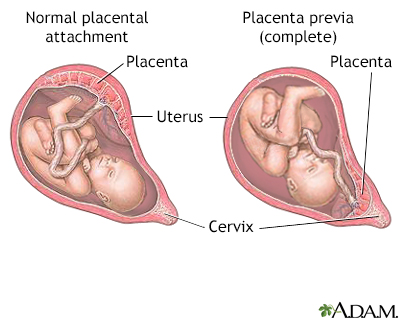| ||||||||||||||||||||||||||||||||||||||||
Placenta previa is a condition that occurs during pregnancy when the placenta implants itself in the lower part of the uterus, obstructing the cervical opening to the vagina.

During pregnancy, your uterus expands away from the cervix. The placenta repositions itself as your uterus stretches and grows. By your third trimester, the placenta should be near the top of your uterus, leaving the cervical opening clear for the delivery. Sometimes, though, the placenta remains in the lower portion of the uterus, partly or completely covering the cervical opening. This condition, called placenta previa, requires you to have a c-section and, in some cases, causes severe, and even life-threatening bleeding or hemorrhage.
There are three types of placenta previa:
Placenta previa occurs in one out of 200 pregnancies. It is more common in women who have uterine fibroids, an abnormally developed uterus, or scarring of the uterine wall caused by previous pregnancies, cesareans, uterine surgery, or abortions. Women who smoke or have their children at an older age may also have an increased risk.
The main symptom of placenta previa is painless vaginal bleeding that often occurs near the end of the second trimester or beginning of the third trimester. There is no abdominal pain or tenderness associated with the bleeding. The flow may be light or heavy, and the color may be bright red. The bleeding may stop on its own but can start again days or weeks later.
Your health care provider will diagnose your symptoms and detect the location of your placenta with an ultrasound exam.
About 7% to 30% of women with placenta previa do not experience vaginal bleeding as a symptom before delivery. In these cases, diagnosis may result from a routine ultrasound exam. Sometimes the condition remains undiscovered until delivery.
If the placenta is near the cervix or is covering a portion of it, you may be placed on a modified schedule with bed rest. You will also be instructed on pelvic rest. This means nothing should be put into the vagina, including no sex and no douching. If there is bleeding, however, you will most likely be admitted to a hospital for careful monitoring. Once you reach a healthy delivery date, your health care provider will most likely deliver your baby by cesarean section. An emergency cesarean may be performed earlier if the placenta actually covers the cervix and the bleeding is heavy or life threatening. Your health care providers will carefully weigh your risk of ongoing bleeding against the risk of an early delivery for your baby.
Since in most cases placenta previa can be diagnosed before the mother or the fetus is in significant danger, it no longer poses as much of a threat to babies and mothers as it once did. The biggest risk is that severe bleeding will require your baby to be delivered preterm.
Some women with placenta previa also have a placenta acreta. This is more common among women who have previously had a c-section or prior surgery inside their uterus (such as dilation and curettage or fibroid removal). If you have a placenta acreta, you may have very heavy bleeding after your baby is delivered. Women with placenta acreta sometimes need to have their uterus removed (a hysterectomy) after delivery.
While placenta previa cannot actually be prevented, it's best to be aware of conditions that may cause it. If you have a history of uterine fibroids, cesarean section, an abnormally developed uterus, or scarring of the uterine wall caused by several pregnancies, abortions, or uterine surgery, make this known to your health care provider as soon as you know you're pregnant.
Q: I am two months pregnant and have a low-lying placenta. Should I be worried that I have placenta previa?
A: In early pregnancy, a low-lying placenta is very common. But as your pregnancy progresses, the enlarging uterus should "pull" the placenta toward the top of your uterus. Ninety percent of women who have a placenta previa on their ultrasound early in pregnancy will no longer have a previa when it’s time to deliver. Your health care provider will monitor the progression of your placenta throughout your pregnancy. If your placenta is still lying low in your third trimester, your provider will watch carefully for signs of placenta previa.
Q: I've had placenta previa before. What are my chances of getting it again during my next pregnancy?
A: The incidence of placenta previa increases with each pregnancy. Your health care provider will check the position of your placenta on an early ultrasound and monitor you closely during your next pregnancy.
Q: What's the difference between placenta previa and placenta abruptio?
A: With placenta previa, the placenta is located over or near the cervix, in the lower part of the uterus. The placenta usually blocks the cervical opening to the vagina. With placenta abruptio, the placenta partially or completely detaches itself from the uterine wall, before delivery of the baby takes place. The two conditions are quite different and not necessarily related.
|
Review Date:
12/9/2012 Reviewed By: Irina Burd, MD, PhD, Maternal Fetal Medicine, Johns Hopkins University, Baltimore, MD. Review provided by VeriMed Healthcare Network. |